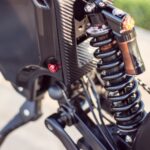Understanding MTB Pedals
Mountain biking requires a combination of skill, strategy, and the right gear to enhance your riding experience. One of the most crucial components of your set-up is the pedals. They might seem straightforward, but the choice between flat and clipless pedals can significantly impact your performance and enjoyment on the trails.
Flat Pedals: The Basics
Flat pedals are probably what most riders are familiar with. No clips, no special shoes required. Just your foot meeting a flat surface. Simple as that! They have a wide platform and provide ample grip, often enhanced by pins that dig into the sole of your shoe.
Advantages of Flat Pedals
- Ease of Use: You can easily place your foot on or off the pedal as desired. No need to worry about clipping in.
- Freedom of Movement: Your feet can shift positions, which is particularly handy when navigating technical terrain.
- Safety: If you take a spill, it’s much easier to get your foot out of the pedal quickly.
- Affordability: Typically, flat pedals are more budget-friendly compared to clipless options.
Disadvantages of Flat Pedals
- Less Efficient Power Transfer: Although you can pedal effectively, you usually lose some power compared to clipless setups.
- Foot Slippage: There might be moments when your foot slips off, especially during technical climbs or descents.
- Shoe Compatibility: While you can wear regular shoes, specialized flat pedal shoes can improve grip but typically come at an additional cost.
Clipless Pedals: The Lowdown
Clipless pedals can sound confusing because they actually involve clipping in. The name comes from the fact you are “clipping” into the pedals, but the system does not use clips in the same way traditional systems might be thought of. For this type, you need special shoes with cleats that lock into the pedals.
Advantages of Clipless Pedals
- Power Transfer: Clipless pedals allow for more efficient energy transfer since both the downstroke and upstroke of pedaling are engaged.
- Control: Having your feet secured in place provides greater stability, particularly on challenging climbs or rugged descents.
- Better for Long Rides: Riders often find that staying clipped in helps reduce fatigue over extended periods as you utilize different muscle groups.
Disadvantages of Clipless Pedals
- Learning Curve: If you’re new to clipless pedals, there’s a bit of a learning curve to get comfortable with clipping in and out.
- Possible Falls: Falling while still clipped in can lead to some awkward moments. Just ask anyone who has ever taken a tumble!
- Cost: They typically cost more than flat pedals, and the required shoes can also add to your expenses.
Price Comparison: Flat vs. Clipless
When it comes to budgets, flat pedals generally come out on top. Even high-quality models usually sit at a lower price point than their clipless counterparts. You can pick up a decent pair of flat pedals for under $50, while entry-level clipless pedals often start around $75. Plus, don’t forget about the shoes. Quality clipless shoes can run anywhere from $80 to well over $200.
If you are just starting out or if you are on a limited budget, you might want to stick with flat pedals. They are generally more versatile and are perfectly acceptable for many riding styles.
Personal Experience: Riding on Both Styles
Having tried both flat and clipless pedals, I can honestly say each has its merit. When I first started, I was on flat pedals, and they felt so comfortable. I could hop off my bike, walk around, and not stress about reconnecting my feet. I remember one day in particular when I was tackling some steep singletrack. My foot slipped off, and while it felt a bit scary, I could quickly regain my balance. That moment solidified my love for flat pedals.
However, as my confidence and skills improved, I decided to give clipless pedals a shot. Initially, it was daunting. I fell a couple of times while trying to clip in quickly, but once I figured it out, I loved how connected I felt to my bike. Climbing became easier, and for long rides, I appreciated the extra efficiency. I recall a particularly grueling climb where I was able to maintain better control over my bike while clipped in. It felt like the bike and I were one.
Which Should You Choose?
Choosing between flat and clipless pedals ultimately boils down to your riding style, comfort level, and personal preference. If you enjoy casual rides through the woods or all-mountain trails, flat pedals might serve you well. They allow for a relaxed experience and handle any unexpected challenges without fuss.
If you are a more serious rider, especially if you participate in racing or often take on technical trails, clipless pedals might be the way to go. They help you maximize your power output and provide better control on tricky descents.
Things to Consider Before Buying
- Your Riding Style: Think about how you ride. More technical trails may require clipless, while leisurely and casual rides usually suit flat pedals.
- Your Experience: If you are a beginner, start with flat pedals to build confidence and skills.
- Budget: Keep in mind the total cost, including pedals and potential new shoes.
- Local Terrain: Rest assured your pedals need to match the trails you frequent. Evaluate your local trails when deciding.
A Quick Recap
So, we’ve covered a lot, huh? If you want the freedom to change your foot position and easily get off the bike, flat pedals are your friend. They are budget-friendly and fantastic for casual riding. On the flip side, if you are looking for improved power transfer and control, then clipping in with clipless pedals is worth considering.
No matter what you choose, make sure it feels right for you. After all, the best pedal is the one that gets you out there enjoying the ride. Happy pedaling!






